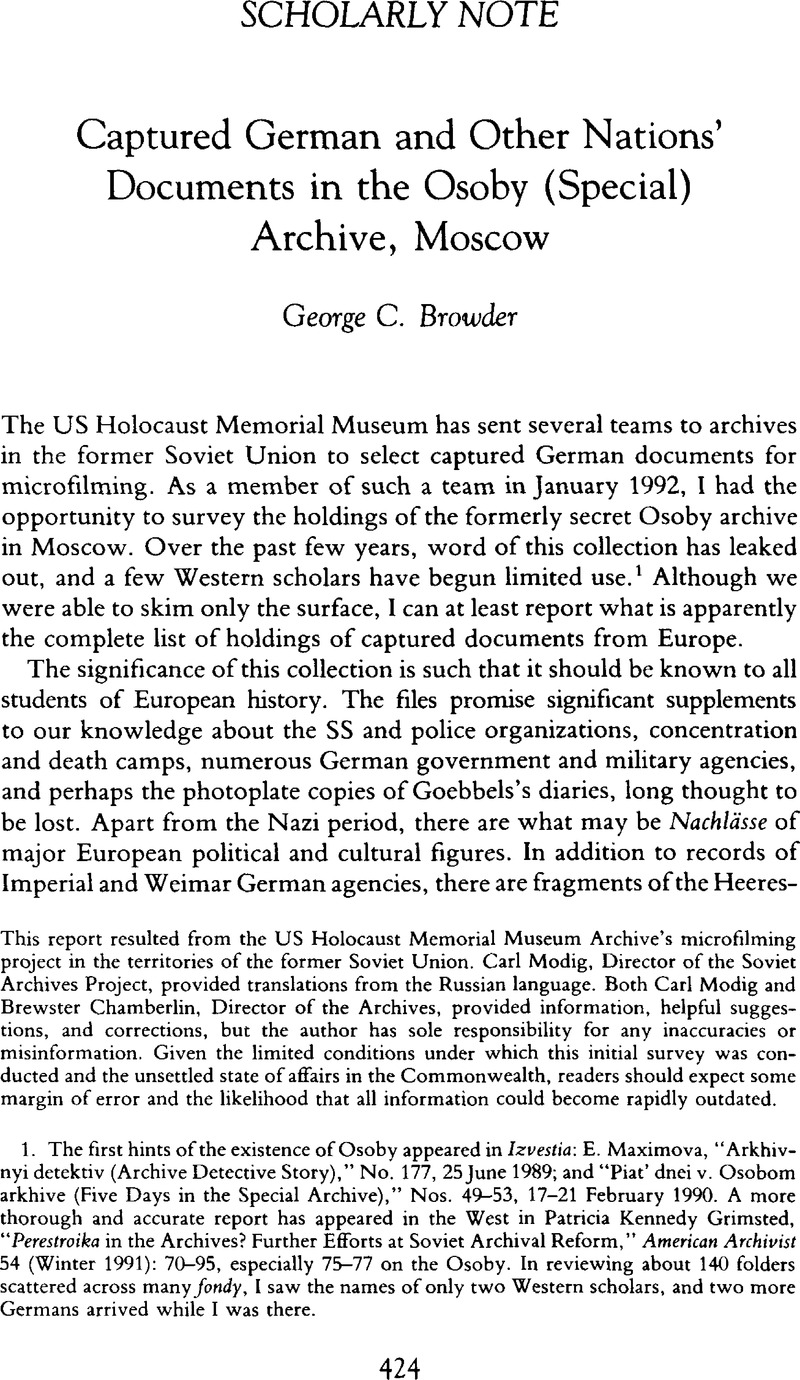Article contents
Captured German and Other Nations' Documents in the Osoby (Special) Archive, Moscow
Published online by Cambridge University Press: 16 December 2008
Abstract

- Type
- Scholarly Note
- Information
- Copyright
- Copyright © Conference Group for Central European History of the American Historical Association 1991
References
This report from the US Holocaust Memorial Museum Archive's microfilming project in the territories of the former Soviet Union. Carl Modig, Director of the Soviet Archives Project, provided translation from the Russian language. Both Carl Modig and the Brewster Chamberlin, Director of the Archives, provided information, helpfull suggetions, and corrections, but the author has sole responsibility for any inaccuracies or misinformation. Given the limited conditions under which this initial survey was conduted and the unsettled state of affairs in the Commonwealth, readers should expect some margin of error and the likelihood that all information could become rapidly outdated.
1. The first hints of the existence of Osoby appeared in Izvestia: Maximova, E., “Arkhivnyi detektiv (Archive Detective Story),” No. 177, 25 06 1989Google Scholar; and “Piat' dnei v. Osobom arkhive (Five days in the Special Archive),” Nos. 49–53, 17–21 February 1990. A more thorough and accurate report has appeared in the West in Grimsted, Patricia Kennedy, “Perestroika in the Archives? Further Efforts at Soviet Archival Reform,” American Archivist 54 (Winter 1991): 70–95, especially 75–77CrossRefGoogle Scholar on the Osoby. In reviewing about 140 folders scattered across many fondy, I saw the names of only two Western scholars, and two more Germans arrived while I was there.
2. The Maximova and Grimsted articles relate details on the capture and retrieval of various catches of documents, something of the story of NKVD exploitation, and their final redistribution among various archives. Also see Grimsted, note 17, re the nowdeclassified internal records of the former Glavarkhiv in the Central Archive of the October Revolution of the USSR, Fond 5325, Opis 10, Delo 2027.
3. The record of the accumulation and return of parts or all of each collection is occasionally found in the introductions of the schmidt, . “Übernahme von Archivgut ausder USSR”, Archivmitteilungen 39, no. 5 (1989): 179–180;Google Scholar and Giles, Geoffrey J., “The Stasi Archive in the Freienwalder Strasse, East Berlin,” German Studies Association Newsletter 16, no. 1 (Winter 1991): 35.Google Scholar
4. This and other Gestapo regional office files are valuable for their perspectives on the daily life of Gestapo work, and they supplement those that have survived in the West. This particular set should also fill in some of the holes in the Prussian Geheime Staatsarchiv publication on this province and Stapostelle.
5. An amalgamated fond of material collected from local police offices of all kinds from all over Germany, including Sipo and SD, Orpo, Inspekteur, Kommandeur, Befehlshaber, and HSSuPf. Each delo is dedicated to a seperate identifiable field office.
6. Transferred, partly to former DDR, partly to other agencies.
7. 7 opisi, 645 dela (1916–1945). See also fondy 1477, 1487, and 1370, 1423. Included in this fond are photographic plates of Goebbels's, diaries, and prints made from those plates. They fit the description of the proto-mircrofiche copies that Goebbels had made of his diaries using the Goebel-Planfilm-Kamera. None of these fondy contain any of the originals that are known to be in Russian possession. See also Fröhlich, Elke, ed., Die Tagebücher von Joseph Goebbels. Sämtliche Fragmente (Munich, 1987), 1: 1x–1xi, 1xii–lxvii, lxx–lxxiii.Google Scholar
8. Materials relating to the payment of German military personnel. SS soldiers, and foreign legion volunteers, 6 opisi, 22,873 dela (1892–1945).
9. Opis 1, 272 dela. (1797–1963). Apparently a holding fond for files whose provenance they could not immediately determine. Many of the original 487 dela have now been transferred to the appropriate fondy. Most of the remaining dela are postwar investigations.
10. Fondy 506 to 1524 contain records of or relating to suspected organizations.
11. Fondy 728–1412 pertain to various lodges in Germany, usually identified by community (one lodge per folder). These are apparently all Masonic lodges, but ignorance prevents me from categorizing them accurately. Consequently, most “lodges” except B' nai B'rith are listed here. Persons looking for the records of a specific lodge will have to enquire to the Osoby, for I have not kept a detailed list. The interested reader should also check the above list for Masonic organizations which I might have missed.
12. Transferred to Ministerial Aparail Nationale, Kishinev, Moldavia in 1960.
13. Names like Koestler, Arthur, Rauschning, Hermann, Rathenau, Walter, Spann, Othmar, Strasser, Otto and Schacht, Hjalmar stand out sharply on the following list. Unfortunately I could not review any opisiGoogle Scholar or folders in this category, so I have no idea what kind of records these are. Some may consist of reports on the individual, examples of his/her publications, or personal papers that were confiscated. Obviously, interested scholars should enquire directly to the Osoby, which might respond with at least some sense of the volume of the material. Especially with names transliterated from the Cyrillic alphabet, the spelling is problematic.
14. Presumably these are archival collections carried away in whole or in part by the Germans and/or Soviet forces. Currently I have no clues as to either what they contain or how completely the archives were plundered. Except for the few opisi I have seen, I cannot report on what has or has not been returned to the nations of origin.
- 4
- Cited by




